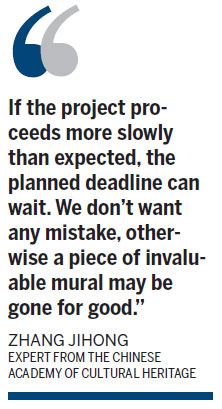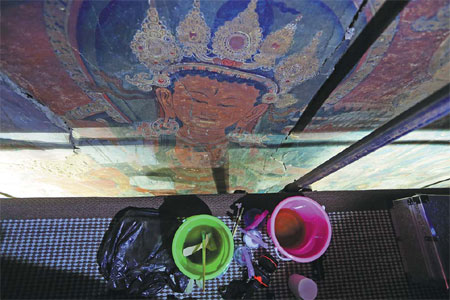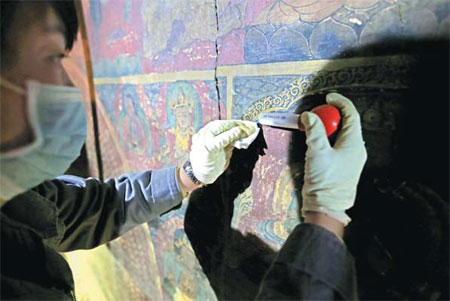Heritage being nursed back to health
Updated: 2013-02-22 07:12
By Daqiong and Li Yao in Lhasa (China Daily)
|
||||||||
|
A mural depicting an imposing Thousand-Hand Guanyin is under renovation at Drepung Monastery in Lhasa, the Tibet autonomous region. Photos by Cui Meng / China Daily |
|
A specialist from the Chinese Academy of Cultural Heritage repairs murals at Drepung Monastery in Lhasa, the Tibet autonomous region. |

Delicate work under way in Tibet aims to save ancient murals
Much-needed repairs are under way to preserve exquisite 600-year-old murals at Drepung Monastery in the Tibet autonomous region.
The project, with funding of 6 million yuan ($961,000) allocated by the central government, will save murals covering an area of 1,042 square meters. They were created around the time the monastery was built in 1614 but have not been opened to visitors since the Qing Dynasty (1644-1911).
The restoration work follows investment of 60 million yuan from the central government between 2006 and 2010 to reinforce the ancient buildings of the monastery, said Jin Yongchun, an official from the Lhasa bureau of cultural heritage.
The monastery, about 10 km west of Lhasa, was expanded to 250,000 square meters and is the largest monastery for the Gelug school of Tibetan Buddhism.
Over time, the murals have bulged or become detached from the walls, as traditional pigments, mainly ox gelatin, aged after centuries of oxidization. The damage included murals deteriorating into flakes, along with mud and smoke damage.
"Without immediate action, large areas of the precious relics will fall off," said Jin Yongchun, an ethnic Tibetan who studied archeology at Sichuan University and who has worked at the Lhasa bureau of cultural heritage for 20 years.
After months of preparations, a repair team from the Chinese Academy of Cultural Heritage began work at the site in early September. It expects to complete the projects in three years.
Zhang Jihong, 32, the team's technical director, arrived in Lhasa in April and is prepared to stay there until the project is completed in 2014.
The team comprises 20 members, all with at least six years' experience in the highly specialized field. They are mostly in their 30s and have young children in their home provinces. Zhang said young people are usually better at adapting to the harsh climate and high altitude on the plateau.
They work on scaffolding about a meter wide that fits in the narrow space between the murals and an outer wall. The path to the site begins from a corner of the main hall. Team members have to use a flashlight to walk on uneven stone steps along a dark passage about 10 meters long.
Once they begin work no one uses mobile phones, or listens to the radio or MP3 players. Neither do they talk much - often the only sound comes from the cleaning devices they use.
Several rounds of basic cleaning removes stains from the surface, with the use of bottled water and tools that include hairbrushes and vacuum cleaners.
Syringes are also used to control liquid flow, because the pulverized pigments have different abilities to absorb water. The liquid can slow the pulverization process, Zhang said.
After basic cleaning, the murals will be removed from walls that have become deformed or cracked. Another company specializing in ancient building renovation will repair the walls. This work will include the injection of grouting materials to consolidate the structure, as the walls have become hollow in some places.
The murals will undergo further cleaning before being reattached to the renovated walls, possibly in August, Zhang said.
The aim is to preserve and restore the murals to their original state. They have a very distinctive style and technique, and if they had been open to the public the damage would have been far greater, Zhang added.
The site will remain closed to visitors even after the repair work is completed, said Losang, deputy director of the governing committee at Drepung Monastery.
Losang, a veteran soldier born in Dagze county, Lhasa, gives logistical support and coordinates the two parallel projects - mural restoration and the renovation of the deformed walls.
"If the two teams have a disagreement, they need to speak out early on. If they remain silent and leave disputed decisions until the last minute, it will be too late," Losang said.
The teams had disagreed on whether to cut into a wall painted with an imposing Thousand-Hand Guanyin, (Avalokitesvara, also known as the Goddess of Mercy), the main Bodhisattva worshipped at the monastery. The mural repairers threatened to stop working if the cut went ahead, and with support of monks at the monastery, this plan was dropped.
Nagwang Choszin, a monk who has spent 25 years at the monastery, said cutting the Bodhisattva painting would hurt believers' feelings. Monks have deep emotions toward ancient treasures passed down for centuries.
Although none of the monks know how to restore relics, some have the skills to create new murals, but new paintings cannot match the relics.
There are some 500 monks at the monastery, with the oldest being over 80 and the youngest still in their 20s. The monks tried to save the murals, using varnish in the 1980s, but this gave the walls a shiny surface.
This work was called off because varnish causes irreversible damage - preventing moisture contained in the paintings from evaporating, which will eventually force open the murals, causing them to fall off the wall.
Zhang Jihong, from the Chinese Academy of Cultural Heritage, said the original pigments, such as ox gelatin, allowed ventilation. The repair team will continue to use these traditional materials, which cause minimal harm because they are water-soluble and can be removed with clean water if anything goes wrong. This way, the murals are likely to last for another 600 years, Zhang said.
Zhang's team follows a tight schedule, with public holidays reduced and extra hours worked on Saturday mornings.
"But we don't rush things through. I have a clear plan every day for each team member. A tiny spot can have several kinds of damage, which needs to be dealt with cautiously. If the project proceeds more slowly than expected, the planned deadline can wait. We don't want any mistake, otherwise a piece of invaluable mural may be gone for good," Zhang said.
Alongside the repair work, a group of Tibetan officials will receive training on the conservation of murals and historical heritage in general, deepening their knowledge about archeology, history and religion.
From April to August, the State Administration of Cultural Heritage held training sessions for officials working in museums or fields relating to relic conservation in Tibet.
Zhang said this is a multi-disciplinary subject, encompassing chemistry, material science, history and archeology. Skills and equipment commonly seen in the medical world - for example, the tubes used for intravenous drips - are placed in cracked walls and injected with grouting materials for structure consolidation.
Kelsang Tsering, 57, deputy dean of the school of arts at Tibet University in Lhasa, is a painter who has staged exhibitions in many countries and also conducted field research at monasteries in Tibet on the conditions of ancient murals, finding that leaks caused by rain remain a widespread problem, leading to damage.
He said it is encouraging to see that both the authorities and the public have become more enthusiastic about the protection of cultural relics. People are beginning to understand that ancient murals passed down for centuries are much more valuable than new paintings, he said.
However, large-scale restoration efforts, supported mainly by the central government, have focused on major temples, with many smaller ones awaiting renovation projects. People interested in art and preserving ancient relics can also contribute and make an investment, Kelsang Tsering said.
Mural restoration work in Tibet requires a combination of modern equipment and local knowledge of the painting skills and traditional materials, he added.
Contact the writers at daqiong@chinadaily.com.cn and liyao@chinadaily.com.cn
(China Daily 02/22/2013 page7)

 In Photos: 7.0-magnitude quake hits Sichuan
In Photos: 7.0-magnitude quake hits Sichuan
 Li Na on Time cover, makes influential 100 list
Li Na on Time cover, makes influential 100 list
 FBI releases photos of 2 Boston bombings suspects
FBI releases photos of 2 Boston bombings suspects
 World's wackiest hairstyles
World's wackiest hairstyles
 Sandstorms strike Northwest China
Sandstorms strike Northwest China
 Never-seen photos of Madonna on display
Never-seen photos of Madonna on display
 H7N9 outbreak linked to waterfowl migration
H7N9 outbreak linked to waterfowl migration
 Dozens feared dead in Texas plant blast
Dozens feared dead in Texas plant blast
Most Viewed
Editor's Picks

|

|

|

|

|

|
Today's Top News
Live report: 7.0-magnitude quake hits Sichuan, heavy casualties feared
Boston suspect cornered on boat
Cross-talk artist helps to spread the word
'Green' awareness levels drop in Beijing
Palace Museum spruces up
First couple on Time's list of most influential
H7N9 flu transmission studied
Trading channels 'need to broaden'
US Weekly

|

|









